Aparisthmium is a plant genus of the family Euphorbiaceae first described as a genus in 1840. It contains only one known species, Aparisthmium cordatum, native to South America and Costa Rica.
Caryodendron is a plant genus of the family Euphorbiaceae first described as a genus in 1860. The genus includes C. orinocense, known as the Inchi tree or Tacay nut. It is native to Central America and South America. They are dioecious trees.
- Caryodendron amazonicumDucke - Amazonas in Brazil
- Caryodendron angustifoliumStandl. - Costa Rica, Panama, Colombia
- Caryodendron janeirenseMüll.Arg. - Rio de Janeiro
- Caryodendron orinocenseH.Karst - Colombia, Venezuela, Ecuador
Astrococcus is a genus of plant of the family Euphorbiaceae first described as a genus in 1854. It contains only one known species, Astrococcus cornutus, native to neighboring states of identical names, Amazonas State in southern Venezuela and Amazonas State in northwestern Brazil.
Acidoton is a genus of plant of the family Euphorbiaceae first described as a genus in 1788. It is native to the Greater Antilles, Central America, and tropical South America.
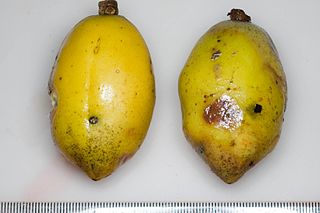
Glycydendron is a genus of plants, under the family Euphorbiaceae first described as a genus in 1922. It is native to South America.
- Glycydendron amazonicumDucke - French Guinea, Suriname, Guyana, Ecuador, Peru, Bolivia, northwestern Brazil, possibly Colombia
- Glycydendron espiritosantenseKuhlm, - State of Espirito Santo in Brazil
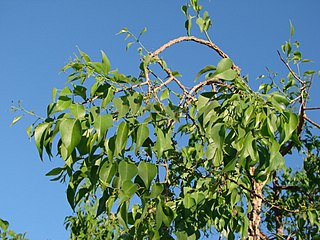
Agonandra is a genus of plants in the family Opiliaceae described as a genus in 1862.
Vvedenskya is a monotypic genus of flowering plants belonging to the family Apiaceae. It just contains one species, Vvedenskya pinnatifoliaKorovin It is also in Subfamily Apioideae.

John Miers, FRS FLS, knight grand cross of the Order of the Rose, was a British botanist and engineer, best known for his work on the flora of Chile and Argentina.

Kerriodoxa elegans, the white backed palm, is the only species of palm tree in the genus Kerriodoxa, in the family Arecaceae.
Steyermarkochloa is a genus of plants in the grass family. The only known species is Steyermarkochloa angustifolia(Spreng.) Judz., which is native to Colombia (Guainía), Venezuela (Amazonas), and Brazil (Amazonas).

Tinantia is a genus of plants in the Commelinaceae, first described in 1839. They are commonly called widow's tears or false dayflowers due to their resemblance of the closely related true dayflowers of the genus Commelina. Tinantia is native to North and South America from Texas + Hispaniola to Argentina, with a center of diversity from Mexico to Nicaragua. Tinantia pringlei, an alpine native of Mexico, is grown as an ornamental in temperate areas and is also a common greenhouse weed.

Miersia is a plant genus in the Amaryllidaceae. All 5 known species are native to Chile and Bolivia.

Apteria is a genus of flowering plants in the Burmanniaceae, first described as a genus in 1834. It contains only one known species, Apteria aphylla, the nodding-nixie, native to the southern United States, Mexico, Central America, the West Indies, and South America.
Weddellina is a monotypic genus of flowering plants belonging to the family Podostemaceae. It only contains one known species, Weddellina squamulosa.
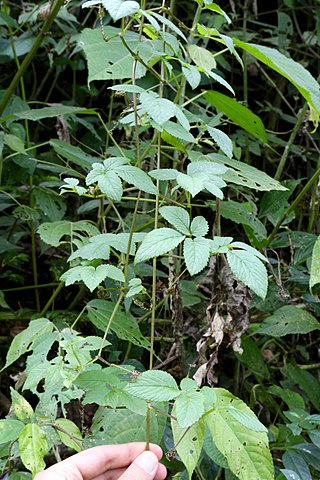
Tourrettia is a monotypic genus of flowering plants belonging to the family Bignoniaceae. It only contains one known species, Tourrettia lappacea(L'Hér.) Willd. The genus of Tourrettia has 2 known synonyms, DombeyaL'Hér. and MedicaCothen. It is also in Tribe Tourrettieae.
Torralbasia is a monotypic genus of flowering plants belonging to the family Celastraceae. It only contains the one known species, Torralbasia cuneifolia(C.Wright ex A.Gray) Krug & Urb.
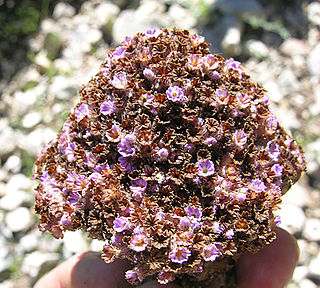
Lennoa is a monotypic genus of flowering plants belonging to the family Boraginaceae. It only contains one known species, Lennoa madreporoidesLex. It is within the subfamily of Lennoaceae.
Solonia is a monotypic genus of flowering plants belonging to the family Primulaceae, with just contains one species, Solonia reflexaUrb.
Ottoschmidtia is a monotypic genus of flowering plants belonging to the family Rubiaceae. It only contains one known species, Ottoschmidtia microphylla(Griseb.) Urb.
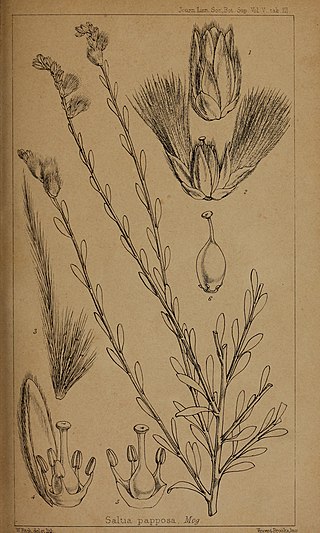
Saltia is a monotypic genus of flowering plants belonging to the family Amaranthaceae. It just contains one species, Saltia papposa. It is in the Amaranthoideae subfamily.









